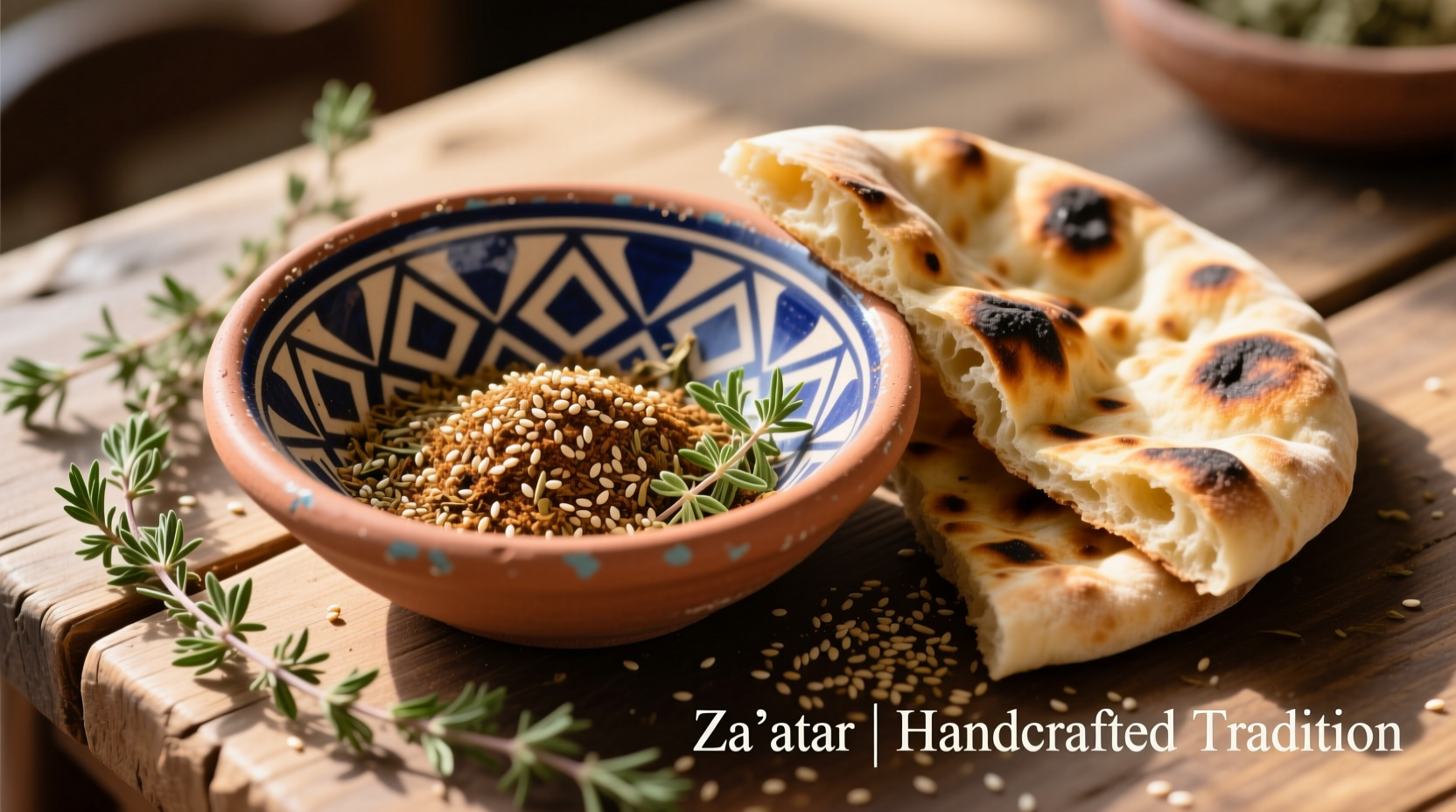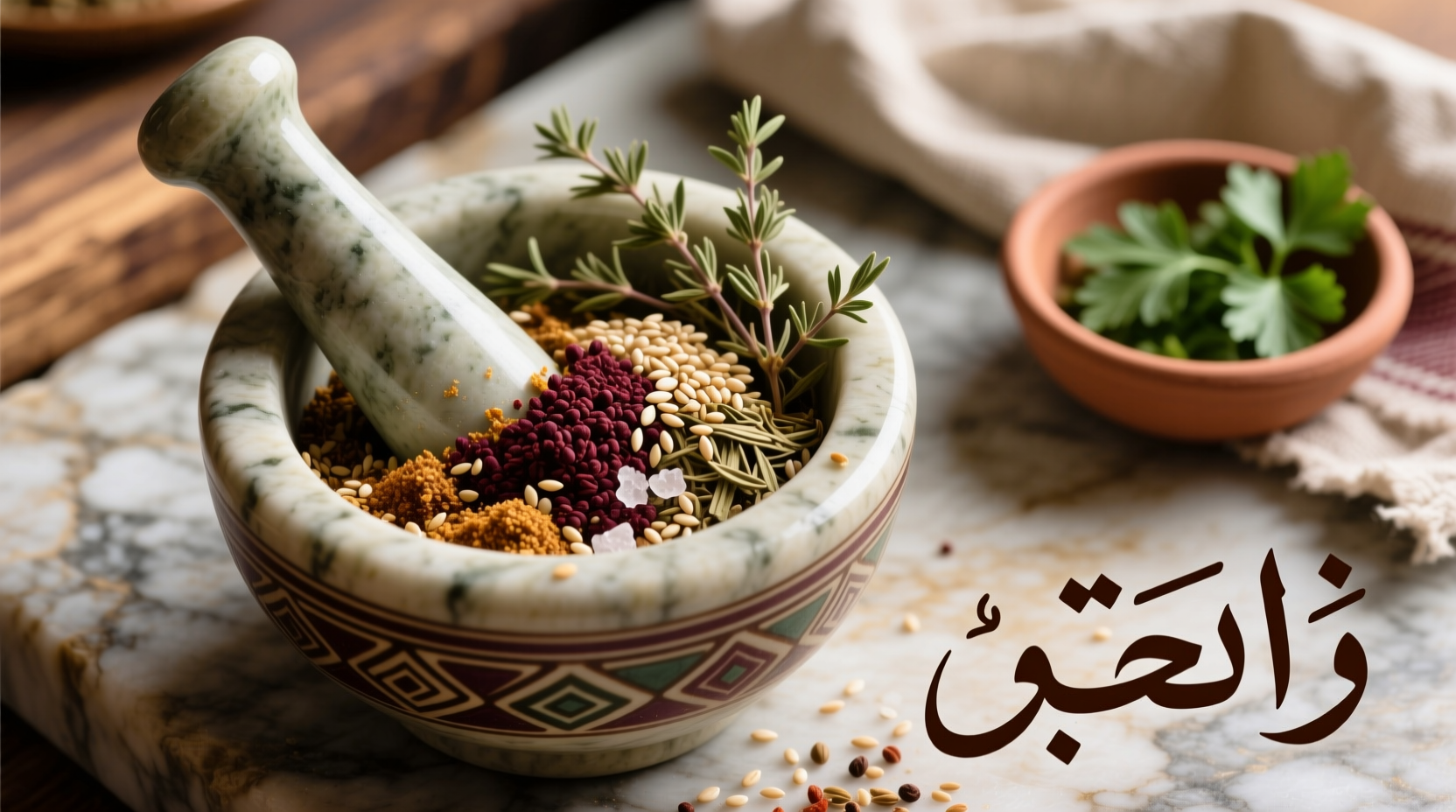Curious about this vibrant spice blend that's gaining popularity worldwide? You've come to the right place. Whether you're encountering za'atar for the first time or looking to deepen your understanding, this guide delivers everything you need to know about this versatile Middle Eastern staple—from its ancient origins to modern culinary applications.
What Exactly Is Za'atar? Beyond the Basic Definition
Before exploring za'atar's rich history, let's clarify a common point of confusion: "za'atar" refers to both a specific wild herb (Origanum syriacum, also called biblical hyssop) and the spice blend named after it. The herb itself has been used for thousands of years in the Levant region, while the spice mixture evolved as a way to preserve and enhance its flavor.
Authentic za'atar spice blend always contains three essential components:
- Dried wild thyme or oregano (the primary herb component)
- Sumac (providing tangy, lemony notes)
- Roasted sesame seeds (adding nuttiness and texture)
Additional ingredients like marjoram, cumin, coriander, or fennel may appear in regional variations, but the core trio remains consistent across authentic preparations.
| Region | Primary Herb | Distinctive Additions | Sumac Percentage |
|---|---|---|---|
| Lebanon | Thyme | Orange blossom water | 25-30% |
| Palestine | Wild za'atar (hyssop) | None | 20-25% |
| Jordan | Oregano | Cumin | 15-20% |
| Syria | Marjoram | Fennel seeds | 25-30% |
This regional comparison table reveals how za'atar adapts to local preferences while maintaining its essential character. According to research published by the National Center for Biotechnology Information, these variations reflect centuries of agricultural practices and cultural exchange across the Levant.
The Historical Journey of Za'atar: From Ancient Remedy to Modern Pantry Staple
Za'atar's story spans millennia, with evidence of its use dating back to ancient Egyptian and Babylonian civilizations. Historical records show that:
- 3000 BCE: Wild za'atar (hyssop) appears in Egyptian medicinal texts for respiratory treatments
- 1000 BCE: Biblical references to "ezov" (Hebrew for hyssop) in purification rituals
- 9th century CE: Persian scholar Ibn Wahshiyya documents za'atar recipes in "Nabataean Agriculture"
- 12th century CE: Maimonides recommends za'atar for memory enhancement in medical writings
- Modern era: Za'atar becomes a protected cultural heritage item in several Middle Eastern countries
This historical timeline demonstrates za'atar's evolution from medicinal herb to culinary essential. The Encyclopædia Britannica confirms that za'atar has maintained continuous cultural significance throughout this 5,000-year history, adapting to changing culinary landscapes while preserving its core identity.

Why Za'atar Matters: Cultural Significance Beyond Flavor
In Middle Eastern cultures, za'atar represents more than just a seasoning—it's a cultural symbol with deep social meaning. The traditional practice of "fatah" involves dipping fresh bread into olive oil, then za'atar, creating a simple yet profound ritual that connects generations.
Anthropological studies from the American Anthropological Association reveal that za'atar preparation often serves as intergenerational knowledge transfer, with elders teaching younger family members the proper ratios and preparation techniques. In many communities, the specific za'atar blend used can indicate family origins or regional heritage.
Practical Guide: Using Za'atar in Your Everyday Cooking
Ready to incorporate za'atar into your cooking? Here are the most effective ways to use this versatile spice blend:
Essential Za'atar Applications
- Bread dipping: Mix with high-quality olive oil for dipping pita or flatbread
- Meat seasoning: Rub on chicken, lamb, or fish before roasting
- Vegetable enhancement: Sprinkle on roasted vegetables (especially eggplant and cauliflower)
- Breakfast boost: Stir into labneh or Greek yogurt for a flavorful spread
- Baking addition: Incorporate into dough for savory breads or crackers
Pro Tips for Maximum Flavor
- Always add za'atar after cooking delicate dishes to preserve volatile oils
- Store in an airtight container away from light to maintain freshness (up to 6 months)
- For intensified flavor, lightly toast the blend in a dry pan before use
- Combine with lemon juice to enhance the sumac's natural tartness
Creating Authentic Homemade Za'atar: A Simple Recipe
While quality store-bought za'atar exists, making your own ensures freshness and authenticity. This traditional ratio balances all elements perfectly:
Classic Homemade Za'atar Recipe
- ¼ cup dried thyme (preferably wild)
- 2 tablespoons dried oregano
- 2 tablespoons sumac
- 3 tablespoons toasted sesame seeds
- 1 teaspoon sea salt
Instructions: Gently toast sesame seeds in a dry skillet until golden. Combine all ingredients in a glass jar and shake well. Let the mixture rest for 24 hours before use to allow flavors to meld. Store in a cool, dark place.
For regional authenticity, adjust ratios based on your preferred style: increase sumac for Lebanese-style (30%), reduce for Jordanian-style (15%), or add a pinch of cumin for authentic Palestinian variation.
Shopping for Quality Za'atar: What to Look For
When purchasing za'atar, watch for these quality indicators:
- Color: Vibrant green herbs with deep red sumac (avoid dull, brownish blends)
- Aroma: Pronounced herbal scent with citrus notes (weak smell indicates old spices)
- Texture: Visible whole sesame seeds and distinct herb particles
- Ingredients: Only natural components (avoid blends with fillers like wheat flour)
Reputable Middle Eastern markets typically offer the freshest blends, as za'atar loses potency quickly after grinding. Check production dates when available, and remember that authentic za'atar should never contain artificial colors or preservatives.
Common Questions About Za'atar
Here are answers to frequently asked questions about this versatile spice blend:
Is za'atar the same as zaatar or zatar?
Yes, these are simply different transliterations of the same Arabic word (زعتر). The spelling varies based on regional pronunciation and translation preferences, but they all refer to the same spice blend or herb.
Can I substitute za'atar if I don't have it?
While not identical, you can create a passable substitute with 2 parts dried thyme, 1 part sumac, and 1 part sesame seeds. For closer approximation, add a pinch of oregano and marjoram. Note that authentic za'atar's unique flavor profile comes from the specific wild herbs used in traditional blends.
Is za'atar spicy or hot?
No, authentic za'atar is not spicy or hot. It has a complex flavor profile featuring earthy herbs, tangy sumac, and nutty sesame seeds. The confusion sometimes arises because some commercial blends add chili powder, but traditional za'atar contains no heat-producing ingredients.
Does za'atar have health benefits?
Yes, research published in the Journal of Ethnopharmacology shows that za'atar's components offer several potential health benefits. Thyme contains thymol with antimicrobial properties, sumac provides antioxidants, and sesame seeds offer healthy fats. Traditional Middle Eastern medicine has used za'atar for digestive aid and respiratory support for centuries.











 浙公网安备
33010002000092号
浙公网安备
33010002000092号 浙B2-20120091-4
浙B2-20120091-4